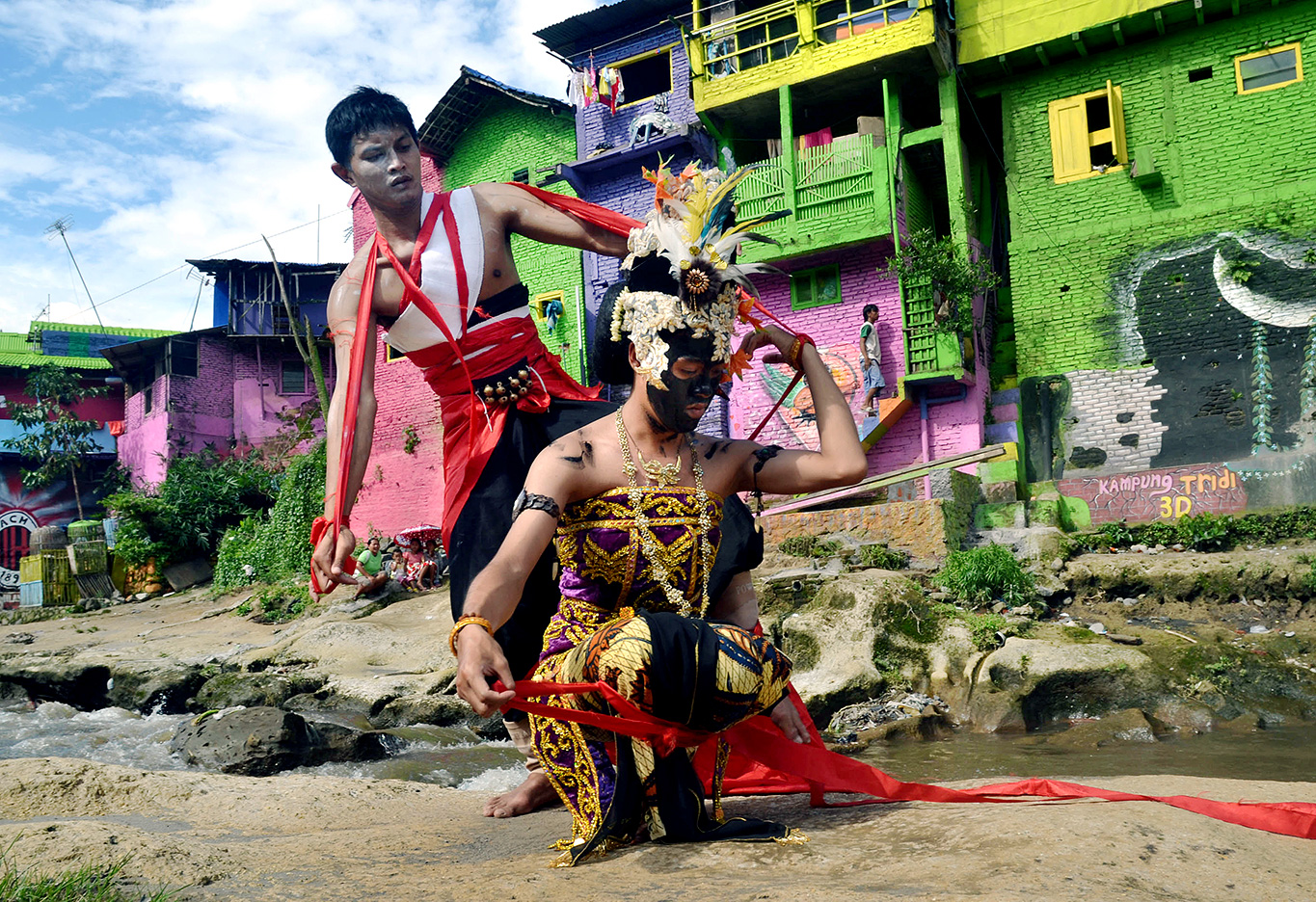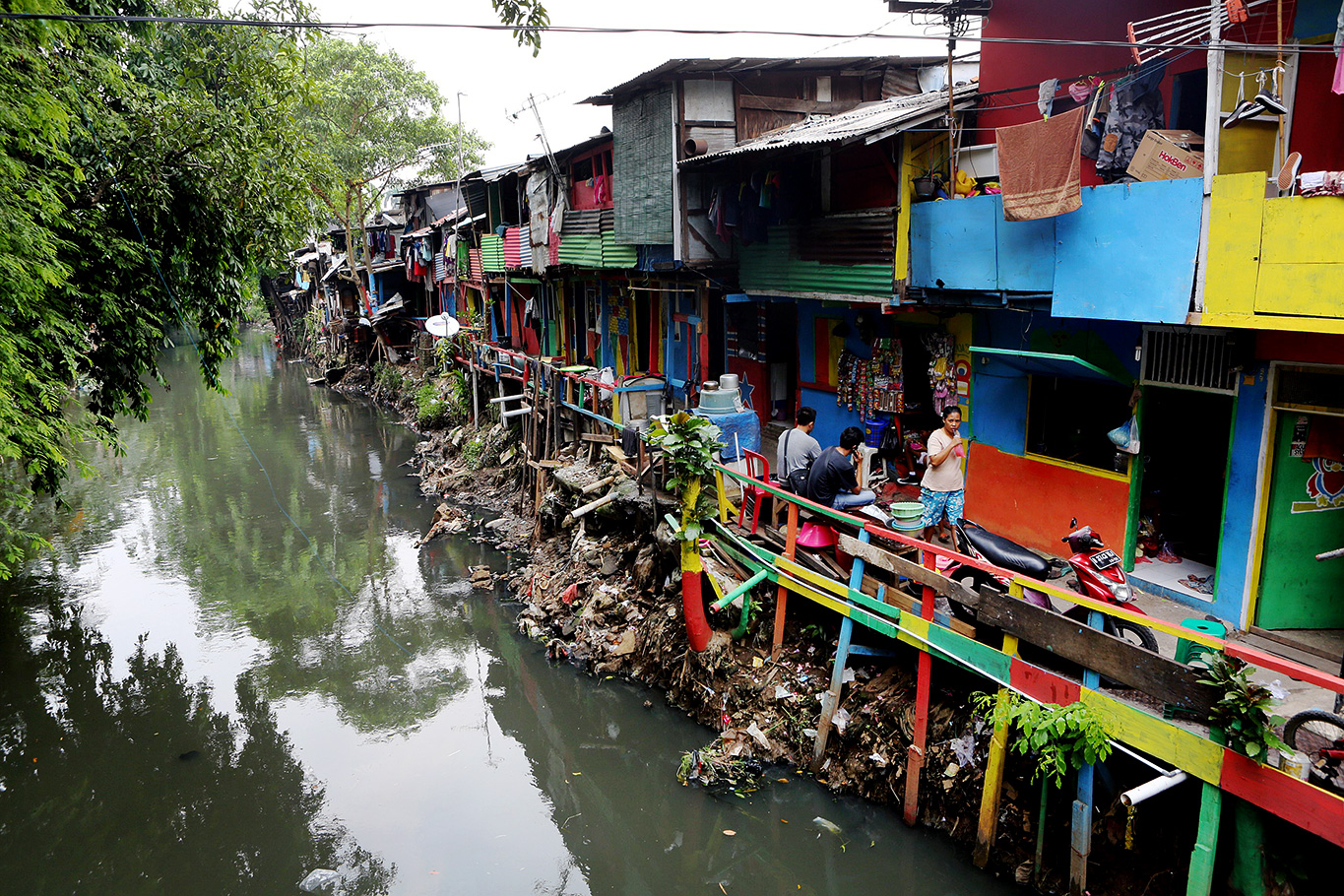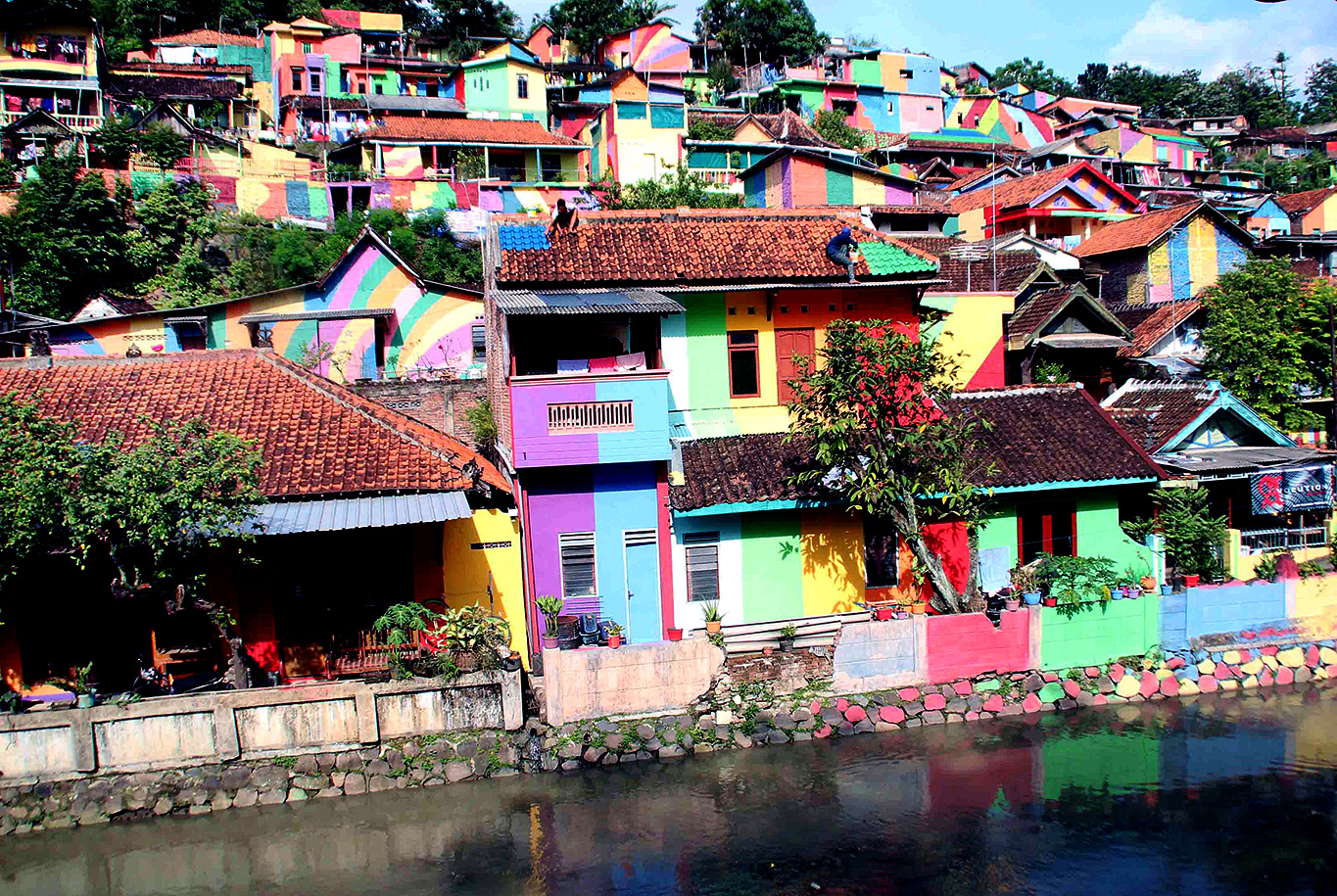Inspired by success stories in Yogyakarta and Malang, an increasing number of slum areas in major cities across Indonesia have transformed into new colorful quarters worthy of sightseeing.
The Jakarta Post writers Corry Elyda in Jakarta and Aman Rochman in Malang take a closer look at how the trend is sparking a new social media craze.
A slum neighborhood in Krendang, West Jakarta, was ablaze with colors on a recent afternoon. The walls of the houses, which lined a sparkling alley, were emblazoned with murals depicting popular cartoon characters. It appeared that the quarter had shed its stinky image.
Unlike anywhere else in Tambora district, which is notorious for fires, gutters in Krendang became surprisingly clean — at least by local standards. The alley came to life at around 3 p.m. with lots of children playing their favorite games in the absence of decent playgrounds.
“Here we can play and admire the cartoons on the walls,” said Samsul Ikhwal Nugraha, 10, who was staring at a picture of a minion, a character from Despicable Me.
The neighborhood that otherwise lacks breathing space now boasts a public garden that helps create a relaxed ambience for its 17,000 residents. The artistry and cleanliness is unusual for a Jakarta slum area. It all began in 2016 after Krendang took part in a cleanliness contest held by the city administration.
Before then, it was a neighborhood that lacked cleanliness and suffered from flooding problems when the banks of the nearby Krendang and Cibubur rivers burst.
As locals would proudly recall, the neighborhood unit had the honor to represent West Jakarta after winning a provincial cleanliness contest. The achievement came as a result of the “Clean and Colorful Alley” campaign, which brought together the community and encouraged them to keep their neighborhood more livable.
“Awareness on keeping the environment clean has been instilled in every resident,” said Maman Sumantri, 40, a neighborhood unit head.
Andre Ravnic, the Krendang subdistrict chief, attributed the victory to the community’s effort to transform their neighborhood by way of tree planting, environmental cleanup and mural painting. “Because the concept turned out to be good, we promoted it and encouraged other neighborhoods [in Krendang] to follow suit.”
Now, all seven community units in Krendang have at least one “clean and colorful” alley. Each community unit manages a 100 to 150 meter alley. They are free to have any theme painted on their walls by artists but the most popular design involves cartoon characters.
Krendang is not alone in the growing number of urban kampung in major cities where visitors can admire cute pastel-hued houses — a trend that has developed into a new hype in recent years. Although the beautification of urban kampung has yet to develop into a national movement, cities like Semarang, Yogyakarta and Palembang in South Sumatra and Balikpapan in East Kalimantan are making changes. As of today, at least nine cities and towns boast “rainbow villages” and more are starting to develop ones.
Yogyakarta, Indonesia’s second best known
tourist destination after Bali, was the first to paint houses colorfully.
It did so along the Code River in 2015, taking inspiration
from the famed the favelas in Rio de Janeiro, Brazil.
Santorini of Java
For world travelers, a neighborhood painted in Technicolor may bring their memories back to fabulously famous places as the rainbow Gamcheon Culture Village in Busan, South Korea, Sidi Bou Said in Tunisia or Cycladic houses in Greece.
Indonesians paint their modest houses, fences or even food stalls bright for various reasons. In Jakarta, they do it largely with communal orderliness in mind. In East and Central Java, they do it for the lofty goal of boosting tourism, which takes a lot more time and effort, and with payoffs that are not immediate. But this seems to be no big issue today, as adventurers are constantly looking for pictures to share on Instagram and other social media platforms.
Obviously, that is what has happened with the Colorful Village of Jodipan in the East Java town of Malang. It may not be as well-known as Gamcheon, but it is fast gaining popularity in Indonesia and overseas thanks to media hype.
Once a slum area by the river of Brantas, Jodipan’s status has risen to a must-visit tourist spot in Malang, where — until 2016 — holidaymakers have known little else about it other than the scenic mountains of Batu. Much credit goes to the imaginative students of Malang Muhammadiyah University (UMM) who came up with the makeover idea and made it happen with the help of the government and private entities.
The Malang administration has officially designated the hilly area with steep alleyways and sharp turns a tourist village, coughing up billions of rupiah for waste management and parking lot construction. Cafes and shops have been mushrooming there to cater to the increasing number of local and foreign visitors, which can top 3,000 on weekends. Gone is the foul reputation that used to keep tourists away.
“The area is now clean and the locals’ economy is improving,” Malang Mayor Mochamad Anton said.
Other cities’ success has inspired the administration to develop more thematic villages across the region, from smart villages to white villages, with the latter drawing inspiration from Santorini, the famous southernmost island of Greece’s Cyclades islands in the Aegean Sea. The goal is to attract tourists who would usually treat Malang as a mere transit point on their way to Mount Bromo and Batu, two traditional tourist destinations near the city.
 A touch of art: Dancers perform during an art festival at the Jodipan Colorful Village in Malang, East Java. The kampung’s novel esthetic design and economic success story have inspired other cities to transform slums into rainbow villages. (JP/Aman Rochman)
A touch of art: Dancers perform during an art festival at the Jodipan Colorful Village in Malang, East Java. The kampung’s novel esthetic design and economic success story have inspired other cities to transform slums into rainbow villages. (JP/Aman Rochman)
Bright prospects
The Jodipan success story is contagious. Semarang, the capital of neighboring Central Java, is the latest to have jumped into the fray with the local government spending around Rp 3 billion (US$218,000) to start a project to give a rainbow makeover to 500 houses on the Brintik Hill in Kalisari village.
Kampung Pelangi (Rainbow Village) has become Semarang’s new tourist attraction, bringing in a growing number of visitors, although it is still a work in progress. People visit to take photographs that they share on social media. It started off as a Rp 9.6 billion renovation of the Kalisari Flower Market.
“But when the market project was completed in December [2016], we thought the area would be even more beautiful if the slum area in the background was revamped as well,” Semarang Regent Hendrar Prihadi said.
The south of Semarang is famous for gorgeous hills, lush greenery and cool air. The ongoing village makeover is expected to draw more visitors to the city, which is renowned for colonial era buildings and Javanese cuisine. The ongoing project seems propitious thanks, again, to social media, where users post pictures of them posing in the village.
From the start, the village has been designed to have a touch of art. Artists have been working on murals depicting characters of Javanese shadow puppets, memes and popular comic characters, among other things.
To enhance the new holiday spot, new infrastructure like roads and waterways as well as food courts, parking lots and souvenir shops will be built. A major attraction is a tower that provides a bird’s eye view from the top of Brintik Hill.
Hysteria, a community of young art and urban development activists, has been involved in the project. Artist Akhmad “Adin” Khoridin founded Hysteria in 2012 with a mission to improve people’s awareness about the need to enhance their neighborhoods. He describes his work as an “ethnographic job”.
“We mingle, make friends, find out what’s interesting about their villages and identify potentials,” he said.
The community came up with the idea of creating mural art and installations as well as holding workshops. Content, history, myth and folklore began to be visualized. The program has been implemented in eight kampung across Semarang with various financial schemes.
“Sometimes, we chip in to buy paint, for example. The residents may give us food. When we earn money from other commercial projects, we will cover everything,” he said.
One of Hysteria’s more notable works is in Kauman, where it transformed a quiet, spooky corner into a vibrant exhibition venue and community library. Now, alleys are clear of parked motorcycles with the presence of a communal parking lot.
In Jakarta, urban development planner Elisa Sutanudjaja praised the beautification efforts but she noted that the works had been initiated for short-term goals and specific localities.
In densely populated areas like Tambora, she argued, residents needed more than just clean and colorful alleyways — they needed more fire extinguishers and flood control infrastructure. A quarter will usually receive proper attention from the local government only if it is productive.
“City governments should never neglect the obligation to revamp slum areas and provide basic necessities like water, decent housing and sanitation for all,” she said.
Without strong long-term support from the government, the tourism goals may not be sustainable. Residents would need a great deal of financial and human resources to keep their villages attractive for tourists for many years to come.
Jakartans turn to art,
self-discipline to escape eviction
In 2016, the Jakarta administration tore down houses in nearly 200 areas, mostly urban settlements, to make way for a variety of development projects ranging from green spaces, to tourism and to flood mitigation.
The authorities saw the kampungs as messy and problematic, with some rife with drug dealers and prostitutes.
Only a few evictees were willing to be relocated to the low-cost apartments 25 kilometers away in the eastern suburbs that the city administration had built. Most were reluctant to move, because the new housing was just too far away and they did not want to start life all over again. Those without Jakarta residence cards were sent back to their hometowns.
The eviction was part of the city government’s vision for a Jakarta free of such informal settlements, and moved their residents and squatters to apartments on the capital’s outskirts.
The heavy-handed measure often met with violent protests from the people who had lived for generations on state property.
But some people were sensible and refrained from waging a battle they could not win. So they turned to peaceful solutions that sought a middle way. Knowing that orderliness was essentially what the authorities were after, they were willing to compromise. With the help of urban planners, activists, academicians and international organizations, they would revamp their kampungs from their own pockets.
At the forefront were the residents of Tongkol, Lodan and Kerapu. The three kampungs were infamous for being dirty and flooding when the Ciliwung River bisecting the area overflowed its banks.
Together, the residents meant to show the world they could transform their neighborhoods into decent residential quarters without taking any money from the city coffers.
Those whose houses stood to close to the riverbanks were willing to divide the structures for the construction of river lanes as mandated by the Environment Law.
Having smaller houses was the first step in accommodating the major projects to follow, including the development of sanitation facilities and helping the government to keep the river clean. They beautified their houses with art, planted trees and grew plants in their yards.
So far, they have proven themselves, and their hard work has borne fruit, attracting the attention of local and international artists and architects. Art buffs can enjoy murals and installations in these neighborhoods.
Gugun Muhammad, who lives in the area, proudly told visitors that more and more professionals came to the kampungs to offer partnerships or joint programs. “We don’t mind the help, but what we need are [programs] that are sustainable,” he said.
Gugun and other residents have big dreams for their kampungs, which are located next to the historic site of Batavia.
“We want to attract more tourists so that we can boost our economy,” said Gugun, a member of the Urban Poor Consortium whose contributions to the city’s redevelopment effort was recognized with the Tokoh Metro 2017 city leader award from the Koran Tempo newspaper.
Revamping the kampungs has not been easy for the residents, and they dream of more than escaping the evictions.
Siti Maymunah, 23, told the Post that splitting her house half seemed like a bad idea at first. Aside from losing income from renting rooms, her family also spent some Rp 30 million (US$2,100) in refurbishing their home. Some of the funds came from the Rp 280 million in interest-free loans that charitable organizations had provided.
Nevertheless, she was happy to see her neighborhood clean and safe. “We want to live here for good. The price we have had to pay is OK, and we’ve proved we can take care of ourselves,” said Siti, who works with a contractor.
She said moving to the low-cost city apartments was not an option, because the distant location would mean she had to spend more on transportation. Besides, she knows the area has a high rate of street crimes.
Many of her neighbors caved in to the government pressure to relocate to the East Jakarta apartments. Losing the comfort of her own residence was something Siti could not imagine.
The idea of living in an apartment also terrified her. “Here [in detached houses], life is easier, as people help each other a lot. If I run out of salt, I can simply go to my neighbor for some. I don’t think I could do that in an apartment,” she said. Looking back, Siti and her like-minded neighbors have no regrets for dividing their houses, because they realized that revamping their neighborhood also meant revamping themselves.
The kampungs’ residents have become more disciplined. They have kicked the habit of dumping their garbage in the river, and each house has been fitted with bins from which sanitation agency workers regularly collect their garbage. They also have a community septic tank and decent bathrooms.
The residents are grateful to the artists and social activists for their help in renovating their urban settlements. And they feel safe from the dreaded eviction — for now.
 Copy cat: Shanty houses in Cipinang, East Jakarta, are colorfully painted to follow the latest trend.
Copy cat: Shanty houses in Cipinang, East Jakarta, are colorfully painted to follow the latest trend.
Here, the health-conscious residents have declared their neighborhood tobacco-free. (JP/Seto Wardhana)
| Reporters | : | Corry Elyda, Aman Rochman, Supriono Hemay |
| Photographers | : | Suherdjoko, Aman Rochman, Seto Wardhana |
| Managing Editor | : | Primastuti Handayani |
| Desk Editors | : | Pandaya, Imanuddin Razak |
| Art & Graphic Design Head | : | Budhi Button |
| Graphic Designers | : | Hengky Wijaya, Swi Handono |
| Technology | : | Mustopa, Sandy Riady Hasan |
| Multimedia | : | Bayu Widhiatmoko, I Gede Dharma JS, Ahmad Zamzami, Rian Irawan |


